100 best places to vacation
Here's one traveler's life list for trips in the Upper Midwest.
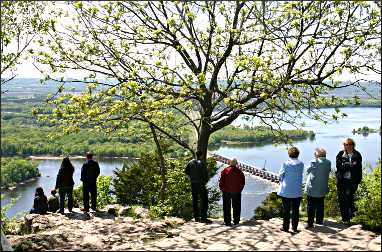
© Beth Gauper
As if we didn't have enough pressures in our lives, now we have "1,000 Places to See in U.S. and Canada Before You Die" as well as the best-selling "1,000 Places to See Before You Die.'
I've been to some of the places listed in those books, but I'll never see them all in my lifetime. I'll have a fine time reading about them, though. Then I'll toss some clothes in a bag and be perfectly happy on my orbits around Lake Superior and the Mississippi.
Our own back yard, while not always glamorous, contains some wonderful places, and you actually have a good chance of seeing them all in your lifetime.
If you need a list, here's one of the 100 best places in the Upper Midwest. When you're finished with it, you'll have so many favorites to revisit you might not have time for that trip to Bora Bora.
For even more great trips, see our Trip Ideas page.
For the best trip to take each month, see A year of best places.
For trips by season, see Best of spring, Best of summer, Best of fall and Best of winter.
Into the wilderness
The Boundary Waters Canoe Area Wilderness is the only Minnesota entry in the original "1,000 Places," and of course, this 1.1 million acre wilderness along Minnesota's border with Canada deserves the honor.
It's easy to visit on a day trip, but its solitude and wide open spaces are best appreciated by campers.
The book also lists the Apostle Islands National Lakeshore on the south shore of Lake Superior, off Wisconsin's Bayfield Peninsula. Kayakers have the best access to the 21-island archipelago, but in summer, visitors can take launches to hiking trails and lighthouses on many of the islands.
In winter, the ice caves on the mainland near Cornucopia, accessible via the frozen lake for a short time in late winter, are one of the region's most splendid and unusual sights.
In far northern Minnesota, the labyrinthine waterways of Voyageurs National Park are full of wildlife and history.
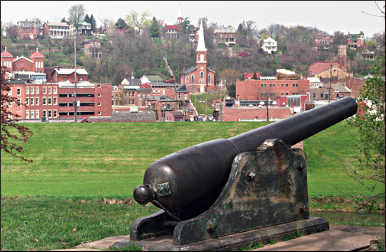
© Beth Gauper
The inland waterways also carried voyageurs and Ojibwe to and from Grand Portage National Monument on Lake Superior, where interpreters re-create a colorful era; the best time to go is during the annual Rendezvous in August.
From Grand Portage, ferries take hikers, campers and kayakers to Isle Royale National Park , a narrow, 45-mile-long island that has 165 miles of hiking trails and the densest population of moose in the lower 48 states.
Pilgrimage to prairie
On the opposite corner of Minnesota, the state's other national monument is a sacred site to Plains Indians, who still quarry the soft red rock that lies under quartzite that erupts out of the earth at Pipestone National Monument.
This marble-like rock, part of the uplifted floor of an ancient sea, rises to a 90-foot-high line of cliffs farther south, in dramatic Blue Mounds State Park.
Just to the east, it pops out of the sod again at Jeffers Petroglyphs, where an ancient people etched their story in nearly 2,000 characters.
Minnesota's North Shore and Lake Superior
Duluth's lakefront, once bypassed by tourists heading up the North Shore, now is hopping. The clanging of the steel Aerial Lift Bridge brings crowds running to see freighters arriving and departing.
It's fun to watch boats next to the canal, but the best views are from Skyline Parkway, 500 feet above town on a terrace that once was the beach of Glacial Lake Duluth.
Heading up the Shore, the cascades of Gooseberry Falls State Park require a stop, as do the view from Palisade Head, Shovel Point in Tettegouche State Park and Split Rock Lighthouse.
Many of the most popular segments of the Superior Hiking Trail are near Lutsen : Carlton Peak, Oberg Mountain and the Cascade River. In Grand Marais, visitors flock to the rocky outcropping of Artists Point.
Inland, a hike to Eagle Mountain takes hikers to Minnesota's highest point. On the Gunflint Trail, skiers find 200 kilometers of groomed trails; stop to eat at the midpoint Trail Center's Black Bear Bar & Restaurant, which transcends the usual skier-snowmobiler antipathies.
It's also a good place to see mushers during the John Beargrease Sled Dog Marathon, and outfitters in the area offer dog-sledding trips you can take yourself.
Back on the North Shore, in Judge C.R. Magney State Park, the Devil's Kettle swallows half of the Brule River; across the highway, Naniboujou and its vivid Great Hall offer a fleeting glimpse of Jazz Age days.
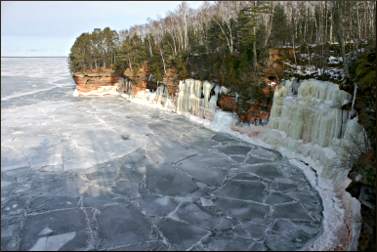
© Beth Gauper
In Grand Portage State Park, the 120-foot High Falls on the Pigeon River are Minnesota's highest waterfall, though they're shared with Ontario.
In Thunder Bay , Fort William Historical Park re-creates the fur-trade era with astonishing thoroughness. In the Port Arthur neighborhood, stop for a meal at the Hoito, an old Finnish logging-camp restaurant.
Then keep going for the other highlights of the magnificent Circle Tour of Lake Superior, with non-stop scenery provided by lighthouses, waterfalls and jagged cliffs.
In Ontario, hike and camp at Sleeping Giant Provincial Park on the Sibley Peninsula and in Pukaskwa National Park. At Agawa Bay, see ancient petroglyphs .
In Michigan, watch the rise and fall of boats through the Soo Locks in Sault Ste. Marie, climb the Grand Sable Dunes in Grand Marais and see the cliffs of Pictured Rocks National Lakeshore on a cruise out of Munising.
Explore the harbor and copper-mining towns of the Keweenaw Peninsula and hike in Porcupine Mountains Wilderness State Park.
In Wisconsin, stop in Bayfield for a show at Big Top Chautauqua and take a detour inland to see the waterfalls at Copper Falls, Amnicon and Pattison state parks.
Sights of Lake Michigan
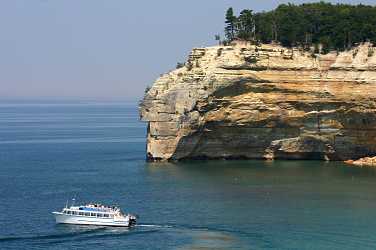
© Beth Gauper
See everything on a Circle Tour of Lake Michigan, one of the nation's great road trips. It's worth the trip just to see the impossibly picturesque Mackinac Island.
If you're on the Straits of Mackinac for Labor Day, take the once-a-year opportunity to walk across the Mackinac Bridge , the world's third-longest suspension bridge.
On the little finger of the Michigan mitten, Sleeping Bear Dunes National Lakeshore is a giant sandbox for all ages, the marquee attraction on the Circle Tour.
From there, a magnificent stretch of beaches and resort towns line the lake, America's freshwater Riviera.
In Chicago, see everything by bicycling the 18-mile Lakefront Trail. Millennium Park and its magnetic Cloud Gate sculpture, or Bean, brings out the crowds, as does the city's architecture.
In Milwaukee, be sure to stop by the spectacular Milwaukee Art Museum to see its brise soleil furl and unfurl. Attend one of its giant ethnic festivals on the lakefront festival grounds — Polish, German, Italian, Mexican.
Wisconsin also has lovely beaches and harbor towns. But many people make a beeline for the Door Peninsula, a vacation playground.
If you're there in spring, see the wildflowers at Ridges Sanctuary ; in summer, take the ferry out to Rock Island State Park. And fall in Door County is gorgeous.
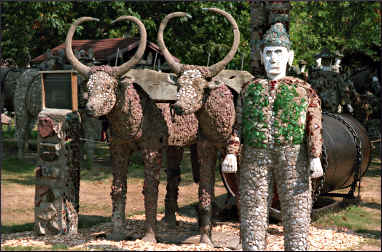
© Beth Gauper
Quirky spots in Wisconsin
In Spring Green, on the Wisconsin River, the Wright masterpiece Taliesin can be visited on tours given by the Frank Lloyd Wright Visitors Center.
A different kind of spectacle sits on a limestone spire overlooking Taliesin and its valley; the over-the-top House on the Rock is said to owe its existence to its builder's desire to spite the haughty architect.
Farther upstream, the fantastical sandstone formations of the Wisconsin Dells were created by a 100-foot wall of water at the end of the last Ice Age, the same kind of deluge that created the Dalles of the St. Croix at Taylors Falls.
Signs of the last glacier can be seen best in Wisconsin by hiking around gorgeous Devil's Lake State Park and on the Ice Age National Scenic Trail and by exploring the glens and hollows of the Baraboo Hills, a 25-mile-long swath recognized as a "Last Great Place" by the Nature Conservancy.
Not far from the Dells, the International Crane Foundation harbors endangered cranes from around the world. In Mirror Lake State Park, the Seth Peterson Cottage is the one of the only Wright-designed buildings the public can rent for private use.
In the last century, Wisconsin has been a crucible for many untrained artists, who work their magic in concrete and shards of glass. Wisconsin's folk-art sculpture environments is perhaps the most spectacular in the nation.
In the northern part of the state, see Fred Smith's Wisconsin Concrete Park in Phillips and the James Tellen Woodland Sculpture Garden near Sheboygan.
In the south, visit the Paul and Matilda Wegner Grotto near Sparta, Prairie Moon Sculpture Garden and Museum near Fountain City and Nick Engelbert's Grandview between Mineral Point and New Glarus.
All were restored by the Kohler Foundation. The Dickeyville Grotto, in the southwest tip of the state, is worth a trip as well.
Coulees and river valleys
The last glacier slid around southwest Wisconsin and the corners of southeast Minnesota and northeast Iowa, leaving a maze of ridges and valleys. It's often called the Driftless Area.
Norwegians settled around Westby; at their annual Snowflake International Ski Jumping Tournament, Olympic-caliber athletes soar off a 118-meter hill that's one of only four its size in North America.
In Vernon County, the son of freed slaves left a collection of round barns, and Amish settled around Cashton and Ontario. On the Kickapoo, paddlers travel in all four directions of the compass in the six miles between Ontario and Wildcat Mountain State Park.
Nearby, the Elroy-Sparta State Trail, with its three tunnels, was the first rail trail in the nation and still the pride of Wisconsin's bike trails.
Madison, with its blindingly white Capitol, museums and lively State Street squeezed onto the isthmus between two lakes, is a destination in every season. Some derisively call it an oasis from reality, and many think that's a good thing.
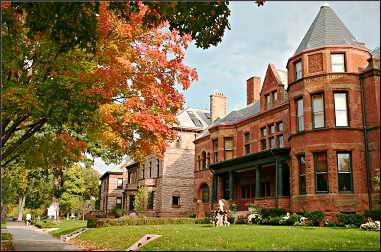
© Beth Gauper
Just to the south, the Swiss settled around New Glarus and Monroe and built an empire of cheese; today, a Limburger-and-onion sandwich at Baumgartner's in Monroe confers instant cheesehead status.
The lead-mining town of Mineral Point drew miners from Cornwall, and its stone facades bear their mark. Their heritage is preserved at the Pendarvis historic site, and art studios and galleries line High Street.
Galena, another lead-mining town across the border in Illinois, also is a magnet for artists, shoppers and Civil War history buffs.
In Iowa, limestone chimney spires and towering bluffs amaze paddlers on the Upper Iowa River near Decorah, a bastion of Norwegian heritage.
In nearby Spillville , where composer Antonin Dvorak spent the summer of 1893, the Bily Clock Exhibit shows what two Bohemian bachelor farmers could whittle over the long, lonely winters.
In cave country across the border in Minnesota, Niagara Cave near Harmony and Mystery Cave near Preston show what drops of water can do over a few long eons. Tour guides offer trips to the many Amish farms.
Nearby, Lanesboro is a magnet for bicyclists, who come to ride the lovely Root River State Trail.
The Mississippi looms large in this region, populated by the spirits of Dakota warriors, French explorers and steamboat captains.
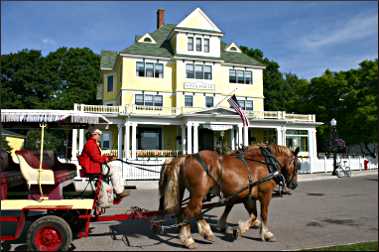
© Beth Gauper
The best views of the Mississippi River give a sense of its scope and power: Barn Bluff in Red Wing; Buena Vista Park in Alma; Brady's Bluff in Perrot State Park, near Trempealeau ; Mount Hosmer in Lansing, in northeast Iowa; Pikes Peak State Park near McGregor ; and Wyalusing State Park near Prairie du Chien.
Chasing wildlife
Wildlife watchers look for different kinds of views. At Horicon Marsh in southeast Wisconsin, thousands of warblers and many other waterfowl stop in spring, and geese descend in fall.
In November, hundreds of tundra swans create a spectacular sight along the Mississippi near Brownsville, Minn., and Rieck's Park in Alma, Wis.
Across the river, in Wabasha and Read's Landing, eagle-watching reaches its zenith between December and March.
On the Mississippi north of the Twin Cities, more than 1,000 trumpeter swans spend the winter at Swan Park in Monticello.
And in April, hundreds flock to blinds in central Wisconsin to watch prairie-chicken courtship.
To the east, black bears frequent Vince Shute Wildlife Sanctuary near Orr, thrilling visitors in summer.
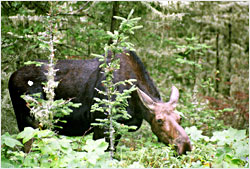
© Beth Gauper
At the International Wolf Center in Ely, resident wolves showcase the alpha and omega of lupine behavior. On the other side of Ely, the North American Bear Center is the place to learn about bruins.
Minnesota lakes country
The headwaters of the Mississippi, in Itasca State Park, are a magnet for schoolchildren around the nation; stay at the Douglas Lodge, which has been housing park visitors since 1905.
From there, the Mississippi heads north to Bemidji, crossing Lake Bemidji near the nation's first giant mascots, Paul Bunyan and Babe the Blue Ox, which have been drawing camera-toting tourists since 1937.
The 106-mile Paul Bunyan State Trail connects Bemidji to Brainerd, the state's busiest lake-resorts area in summer.
One of Minnesota's newest attractions cuts through the best of the Iron Range. Riding the Mesabi Trail between Grand Rapids and Eveleth will be a revelation to anyone who hasn't seen an emerald-green mine-pit lake or such Iron Range sights as Virginia's Mineview in the Sky or Hill Annex Mine State Park in Calumet.
The Mesabi Trail eventually will reach Tower, site of Soudan Underground Mine State Park , where visitors get into an elevator and descend the equivalent of seven football fields into the Earth.
The Twin Cities
In the Twin Cities, no Minnesotan is worth his salt if he hasn't done the basics. In Minneapolis, walk or bike along the river and lakes on the Grand Rounds. On the riverfront, walk across the Stone Arch Bridge and see a play at the Guthrie Theater.
South of downtown, visit Minnehaha Falls and then cross the river to drive along St. Paul's Summit Avenue and ogle the beautifully preserved Victorian mansions.
I wouldn't include a big shopping mall even if it is the Mall of America, but they say it's the state's No. 1 attraction.
Festivals
To see the cities at their best, go to Minneapolis' Aquatennial in July, one of the best summer festivals, and see the ice sculptures during St. Paul's Winter Carnival, one of the best winter festivals.
In February, the Luminary Loppet on Minneapolis' Chain of Lakes is one of the most magical things you can do in winter, along with dozens of other candlelight skiing and snowshoeing evenings around the region.
Minnesotans, of course, must go to the Minnesota State Fair, Iowans to the Iowa State Fair and everyone in Wisconsin to the Wisconsin State Fair, all in August.
Cheeseheads also must attend at least one game at Lambeau Field in Green Bay (if they can get a ticket).
Norwegians must go to July's Nordic Fest in Decorah, and Nordic skiers must sign up for at least one Birkebeiner or Korteloppet from Cable to Hayward, Wis., in February.
Everyone should attend a few powwows, and it would be a shame to miss the Lumberjack World Championships in Hayward in July.
Also be sure to catch the September Civil War battle re-enactments at the Wade House in Greenbush, Wis.; May's Tulip Time in Pella, Iowa; or, in Winnipeg, the fabulous Folk Festival in July and Folklorama in August.
It shouldn't take a lifetime to polish off this list — but if it does, I'd consider it a lifetime well-spent.